Written by Dr David Owens ![]() and Dr Winnie Chui
and Dr Winnie Chui
Background
Vaccination against COVID-19 has been shown to be highly effective in reducing death and disease severity in numerous international studies[1][2][3]. It has been estimated that vaccination has saved more than ten thousand lives from COVID-19 in the UK alone in the first three months of 2021[4]. There is also increasing evidence of a reduction in transmission[5].
In Hong Kong, vaccination uptake has been slow. An efficient, easy-to-use and free vaccination program has an excess of vaccines and often empty vaccine halls. The reasons for the low uptake have been the subject of debate and the government has progressively expanded access to younger people and modified some social distancing measures in an effort to nudge vaccination rates.
Before the COVID-19 pandemic, the WHO described vaccine hesitancy as one of the ‘ten greatest challenges to global health’[6]. Hong Kong is showing high levels of vaccine hesitancy, yet vaccination represents the best chance to escape the current public health restrictions. In January 2021 we undertook an email survey in order to identify perceptions of COVID-19 vaccination within our population. This survey suggested a high intention to vaccinate with 90.4% of patients who responded indicating that they intended to get vaccinated. This was significantly higher than a University of Hong Kong study taken in the same week which showed a 46% intention to vaccinate.
We recently completed a follow-up survey. OT&P patients are subject to the same public health restrictions and the same risks of both disease and quarantine but appear to have markedly different intentions to vaccinate in comparison to the greater Hong Kong population. Our goal was to compare vaccine intentions with actions in addition to exploring attitudes and beliefs around vaccination. We were looking to identify potential factors which may explain the different immunisation rates within our patient population in addition to factors that may be associated with, and by definition could be targeted to improve population uptake.
Method
The survey comprised an e-questionnaire. The questionnaire was emailed to all OT&P patients who have requested inclusion in the newsletter database in addition to all OT&P staff.
Result
Demographic data
We received 3,633 responses. The demographic data are summarised below. This cohort tends to be older and more international than a typical Hong Kong population.
| Total numbers by age |
|
| Age Group | Grand Total |
| ≥ 60 | 689 |
| 35 - 59 | 2560 |
| 19 - 34 | 374 |
| ≤ 18 | 12 |
| Grand Total | 3633 |
There were slightly more female respondents (53.6%) than male (46.4%). Only 10.6% (386/3633) are under 35 years of age. The international nature of the demographic is demonstrated by the fact that there are 24 different languages spoken at home, English being the most commonly spoken. The skewed educational demographic is demonstrated by the fact that 90.0% (3271/3633) of the respondents have at least an undergraduate degree and 51.1% (1857/3633) have a postgraduate degree. Other than the lack of vaccination in children and adolescents, subgroup analysis showed no difference in vaccination rates by age, gender or educational level.
| Highest Level of Education Completed | |
| Secondary / high school | 247 (6.8%) |
| Undergraduate | 1414 (38.9%) |
| Postgraduate | 1859 (51.1%) |
| Prefer not to say | 115 (3.2%) |
Vaccination uptake and hesitancypatients + doctors + staff
Of the total number who responded, 88.9% indicated that they had completed at least one dose of the vaccination and 60.3% were fully vaccinated.
| Vaccination Status | |
| Fully vaccinated | 2193 (60.3%) |
| Received 1st shot and waiting for 2nd | 1033 (28.4%) |
| Received 1st shot and will not take 2nd | 7 (0.1%) |
| Have not received a vaccine | 402 (11.0%) |
Of those who have been vaccinated, there is a clear preference for the BioNTech vaccine 96.0% versus Sinovac 2.6%. Some patients (1.4%) have received other vaccines whilst living outside Hong Kong.
| Vaccination Choice BioNTech/Sinovac/Other |
|
| BioNTech | 3102 (96.0%) |
| Sinovac | 83 (2.6%) |
| Other | 46 (1.4%) |
Of patients who have not been vaccinated 207 scored 9 or 10 on a ten-point scale in which 10 indicated a definite intention to be vaccinated in the future. 192 patients scored 8 or less indicating 5.3% of OT&P respondents to be vaccine-hesitant currently. When comparing the vaccine-hesitant members of this cohort with those who have been vaccinated a number of factors appear to have a greater influence.
| Expressed belief versus action Percentage for high scores for belief (>8) |
||
| Vaccinated | Vaccine hesitant | |
| The importance of high vaccine uptake in Hong Kong | 97.1% | 22.4% |
| Trust in family doctors | 81.2% | 22.4% |
| Importance of vaccination in general | 84.3% | 34.4% |
| Family and friends have been vaccinated | 78.7% | 29.2% |
| Trust in the advice of HK Health Department (CHP) | 55% | 8.3% |
| Trust international media | 36% | 9.9% |
| Worry about quarantine | 65.6% | 45.8% |
| Trust HK media | 17.3% | 6.3% |
Vaccine side effects
Side effects were less common with Sinovac than BioNTech vaccine. 79.5% of patients taking Sinovac reported no side effects compared to 50.4% taking BioNTech. Of those who answered yes to side effects, 41.2% rated the side effects as mild-moderate (1-5). 4.8% of patients who took Sinovac ranked their side effects as between 6-10 on a severity scale (moderate to severe) in comparison to 8.4% who took BioNTech. Only 2 people indicated that the side effects would stop them from taking a further dose.
| Difference in Side Effects Sinovac v BioNTech 1-10 scale, 10 is most severe |
||
| Sinovac | BioNTech | |
| No side effects (0) | 66 (79.5%) | 1564 (50.4%) |
| Mild-Moderate side effects (1 - 5) | 13 (15.6%) | 1277 (41.2%) |
| Moderate-severe side effects (6 - 10) | 4 (4.8%) | 261 (8.4%) |
Vaccination process
The process of booking and vaccination was viewed positively by the majority of respondents. The booking process was rated as very good to excellent (8-10) by 95.5% and the vaccination process was rated as very good to excellent by 97.3%.
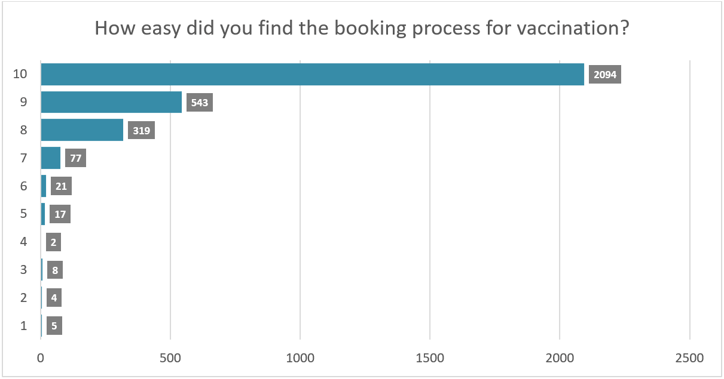
Fig 1. A graph that illustrates our survey's respondents' view on the Hong Kong Government's booking process for the COVID-19 vaccination. 1 = extremely poor, 10 = excellent.
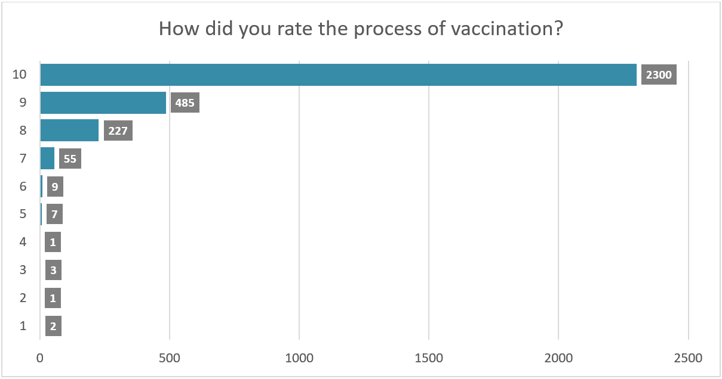
Fig 2. A graph that illustrates our survey's respondents' view on the Hong Kong Government's vaccination process for the COVID-19. 1 = extremely poor, 10 = excellent.
Attitudes to COVID-19 versus quarantine
Respondents to this survey show greater concerns about they or a family member being quarantined than they do about the disease process. The public health restrictions have had an impact on the physical and psychological well-being of significant numbers of people.
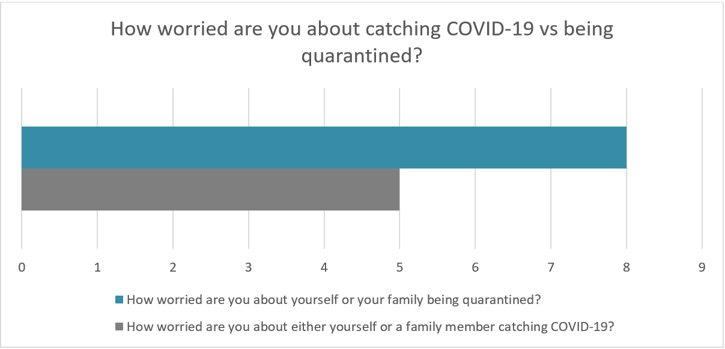
Fig 3. A graph that illustrates the median of our survey's respondents' view on their worries about catching COVID-19 vs being quarantined. 1 = not worried at all, 10 = extremely worried.
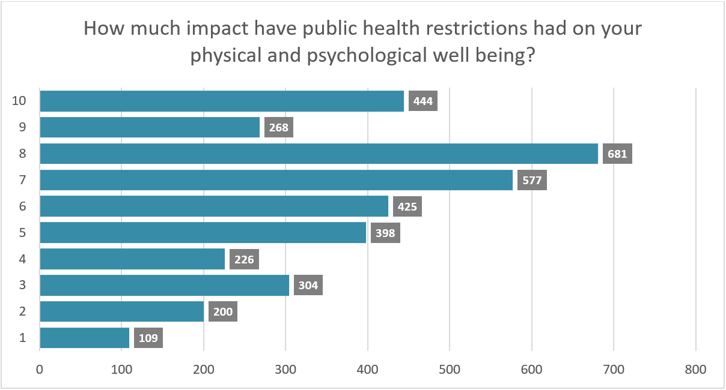
Fig 4. A graph that illustrates our survey's respondents' view on the impact Hong Kong's public health restrictions had on their physical and psychological well being. 1 = no impact at all, 10 = extremely impacted.
Beliefs around vaccination and trust in information resources
In general OT&P patients have a high level of trust in vaccination for diseases other than COVID-19 and feel high vaccine uptake to be very important for Hong Kong. As with many international studies, trust in advice given by a family doctor is an important factor in vaccination. This cohort is generally trusting of advice given by the Department of Health and Centre for Health Protection. There seems to be greater trust in international news media than local media regarding vaccination information.
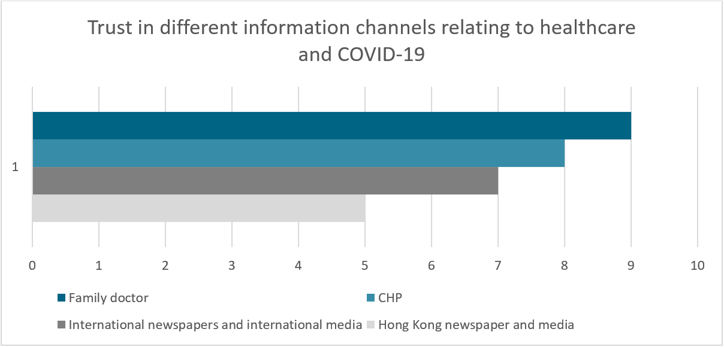
Fig 5. A graph that illustrates the median of our survey's respondents' view on their trust in different information channels relating to vaccination for COVID-19. 1 = not reliable at all, 10 = extremely reliable.
Should vaccinations be mandatory?
This cohort had relatively high levels of belief in mandatory vaccination. 61.1% strongly agree with a statement that vaccination should be compulsory for any adults other than those with medical justification with 66.6% strongly agreeing with a proposition that employers be entitled to information about the vaccine status of employees. 61.8% of respondents expect all staff in a restaurant to be vaccinated with slightly higher numbers expecting the same of all staff in a medical clinic (78.7%).
Factors that may improve vaccination in vaccine-hesitant individuals
Excluding individuals who have already been vaccinated in addition to those who have indicated a definite intention to being vaccinated, this OT&P cohort includes 192 vaccine-hesitant individuals representing 5.3% of the total cohort. The most effective nudges in this population consistently relate to relaxation of quarantine restrictions for vaccinated individuals. This is consistent with our initial survey. Again, financial payment ($5,000 in this case) is significantly less effective as an incentive. Loosening social restrictions on gatherings is the least effective intervention in this population.
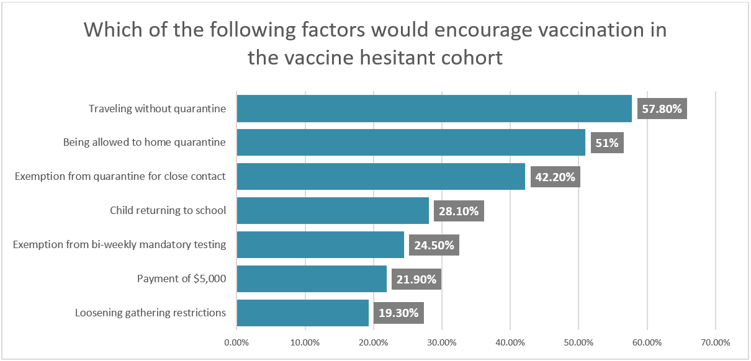
Fig 6. A graph that illustrates our survey's vaccine-hesitant respondents' view on the factors that would encourage vaccination.
Discussion
There are again limitations to this survey. It was an email survey conducted in English with recognised and acknowledged potential for selection bias. The OT&P demographic is not representative of the Hong Kong population. This cohort is older, more international and is skewed in terms of educational and socioeconomic factors. However, it is a population which is subject to the same public health restrictions, the same low risks of COVID-19 within Hong Kong at this time and the same barriers to vaccination (minimal). It is therefore an interesting cohort in which to study the different factors which both drive and inhibit immunisation in Hong Kong.
This cohort of patients have engaged with ongoing public health content via OT&P newsletters and generally have a positive view towards vaccination for COVID-19. The uptake is high, 88.9% of OT&P patients who responded to this survey have had at least one vaccination compared to 13.4% of the population of Hong Kong. A further 5.7% indicate a definite intention to be vaccinated in the future leaving an estimated vaccine-hesitant proportion of 5.3%. In our initial survey which was conducted before the vaccine program was rolled out, 90.4% of respondents indicated an intention to vaccinate. This follow-up shows a high correlation of intention with action and a low vaccine hesitancy rate.
In choice of vaccination, 96.0% of respondents chose BioNTech versus 2.6% choosing Sinovac and 1.8% having other vaccines whilst overseas. Among other factors, the choice of BioNTech may possibly be influenced by the increasing evidence of vaccine efficacy and effectiveness which has been published internationally since the initial survey.
Although the majority of patients reported no or minimal side effects, a small but significant percentage of people reported more significant post-vaccine symptoms with 9.9% taking time off work. Side effects are more common with BioNTech than Sinovac, consistent with international reporting. Only 2 patients indicated that they would not take a further vaccine due to the side effects. At least in our population it does not seem that side effects are a significant barrier to vaccination. Likewise, the process of booking and vaccination is consistently viewed in positive terms with ease, convenience and free vaccines minimizing barriers to vaccination.
This survey supports the findings of our initial survey, in addition to anecdotal experience, that OT&P patients are significantly more worried about public health restrictions, in particular the fear of quarantine, than about the disease itself. Normalisation of life with reduction in public health controls appears to be the primary driver to vaccination in this population. Relaxation of quarantine in different circumstances is again reported as the most effective nudge towards vaccination in vaccine-hesitant individuals.
Unravelling the complex interaction of social, cultural and psychological factors which influence beliefs and actions around vaccination is challenging. Trust in political and health structures and systems is a significant factor in population terms. Hong Kong has not been directly impacted by the disease and this undoubtedly influences the perceptions of disease risk. Even in countries with high mortality and social impact we see a significant difference in vaccine acceptance. The different levels of vaccine hesitancy in the UK and France is a good example of a significantly different response to an apparently similar level of threat. This OT&P cohort reports a relatively high level of trust in vaccination, a belief in the importance of high population uptake and trust in the information provided by both the Hong Kong health department and family doctors. All these factors have been shown in previous studies to correlate with higher population uptake of vaccination. It is notable that there is a significant discrepancy in the factors above in addition to the frequency of vaccination between friends and family in the vaccinated and vaccine-hesitant cohorts of OT&P. These factors seem to be of greater influence than the fear of quarantine. This provides further evidence for the importance of targeted education including role models who are capable of reaching groups with different beliefs and influences.
There is not a high level of trust in media in this population with a slightly higher trust in international over local media. This may simply be a reflection of an international cohort with English as the dominant language. This population may also be expected to have a personal connection to people and locations with higher disease impact. They are possibly more likely to have been ‘touched by the realities of the epidemic’. For an international cohort, there is a surprisingly high acceptance of mandated vaccination in others. It is likely that frustration of low vaccine uptake and the prospect of ongoing social restrictions is driving this response.
It is our opinion that Hong Kong must begin to treat fully vaccinated individuals as if they are immune. It is true that risks cannot be completely eliminated but Hong Kong has very low levels of community transmission. Over 75% of infections occur in mask off situations and masked infections are associated with lower viral load[7]. Individuals who are fully vaccinated and masked represent an extremely low risk. Reducing quarantine requirements for fully vaccinated close contacts and travellers is likely to not only increase vaccine uptake but also reduce total infections by focusing more effective quarantine processes on smaller and higher risk situations. In order to boost vaccine uptake, it is our opinion that Hong Kong should produce a road map of targets and specific benefits attributable to vaccinated individuals.
Ultimately, education and honest information are key factors in managing epidemics. Public health interventions must balance our increasing and evolving understanding of the impact of the disease on both individuals and the health system with the social and economic costs of the interventions within the specific context of the social, cultural and economic needs of the people of Hong Kong. High uptake of an effective vaccine represents the best opportunity for Hong Kong to normalise the current public health restrictions. This will require consistent honest but positive messaging around the evidence of the benefits of vaccination in addition to creative strategies for managing vaccine hesitancy in demographics with higher vaccine scepticism and lower uptake.
Reference
1. Hall, V. J., Foulkes, S., Saei, A., Andrews, N., Oguti, B., & Charlett, A. (2021, April 23). COVID-19 vaccine coverage in health-care workers in England and effectiveness of BNT162b2 mRNA vaccine against infection (SIREN): a prospective, multicentre, cohort study. Victoria Jane Hall, FFPH Sarah Foulkes, MSc Ayoub Saei, PhD Nick Andrews, PhD Blanche Oguti, MSc Andre Charlett, PhD et al. Published:April 23, 2021DOI:https://doi.org/10.1016/S0140-6736(21)00790-X PlumX Metrics. https://www.thelancet.com/journals/lancet/article/PIIS0140-6736(21)00790-X/fulltext.
2. Vasileiou E; Simpson CR; Shi T; Kerr S; Agrawal U; Akbari A; Bedston S; Beggs J; Bradley D; Chuter A; de Lusignan S; Docherty AB; Ford D; Hobbs FR; Joy M; Katikireddi SV; Marple J; McCowan C; McGagh D; McMenamin J; Moore E; Murray JL; Pan J; Ritchie L; Shah SA; Stock S; Torabi F; T. (2021, April 23). Interim findings from first-dose mass COVID-19 vaccination roll-out and COVID-19 hospital admissions in Scotland: a national prospective cohort study. https://www.thelancet.com/journals/lancet/article/PIIS0140-6736(21)00677-2/fulltext#%20.
3. Centers for Disease Control and Prevention. (2021, April 1). Interim Estimates of Vaccine Effectiveness of BNT162b2 and mRNA-1273 COVID-19 Vaccines in Preventing SARS-CoV-2 Infection Among Health Care Personnel, First Responders, and Other Essential and Frontline Workers - Eight U.S. Locations, December 2020–March 2021. Centers for Disease Control and Prevention. https://www.cdc.gov/mmwr/volumes/70/wr/mm7013e3.htm.
4. England, P. H. (2021, April 8). COVID-19 vaccines have prevented 10,400 deaths in older adults. GOV.UK. https://www.gov.uk/government/news/covid-19-vaccines-have-prevented-10-400-deaths-in-older-adults.
5. Centers for Disease Control and Prevention. (n.d.). Science Brief: Background Rationale and Evidence for Public Health Recommendations for Fully Vaccinated People. Centers for Disease Control and Prevention. https://www.cdc.gov/coronavirus/2019-ncov/science/science-briefs/fully-vaccinated-people.html.
6. “Ten Health Issues WHO Will Tackle This Year.” World Health Organization, World Health Organization, www.who.int/news-room/spotlight/ten-threats-to-global-health-in-2019.
7. Martín-Sánchez M; Lim WW; Yeung A; Adam DC; Ali ST; Lau EHY; Wu P; Yuen KY; Leung GM; Cowling BJ; (2021, April 21). COVID-19 transmission in Hong Kong despite universal masking. https://www.journalofinfection.com/article/S0163-4453(21)00205-X/fulltext.
 Central General Practice
Central General Practice
 Repulse Bay
Repulse Bay
 Clearwater Bay
Clearwater Bay
 BodyWorX Clinic
BodyWorX Clinic
 Central Specialist Clinic
Central Specialist Clinic
 MindWorX Clinic
MindWorX Clinic
 Partner Clinics
Partner Clinics
 Family Clinic
Family Clinic
 OT&P Annerley Midwives Clinic
OT&P Annerley Midwives Clinic





